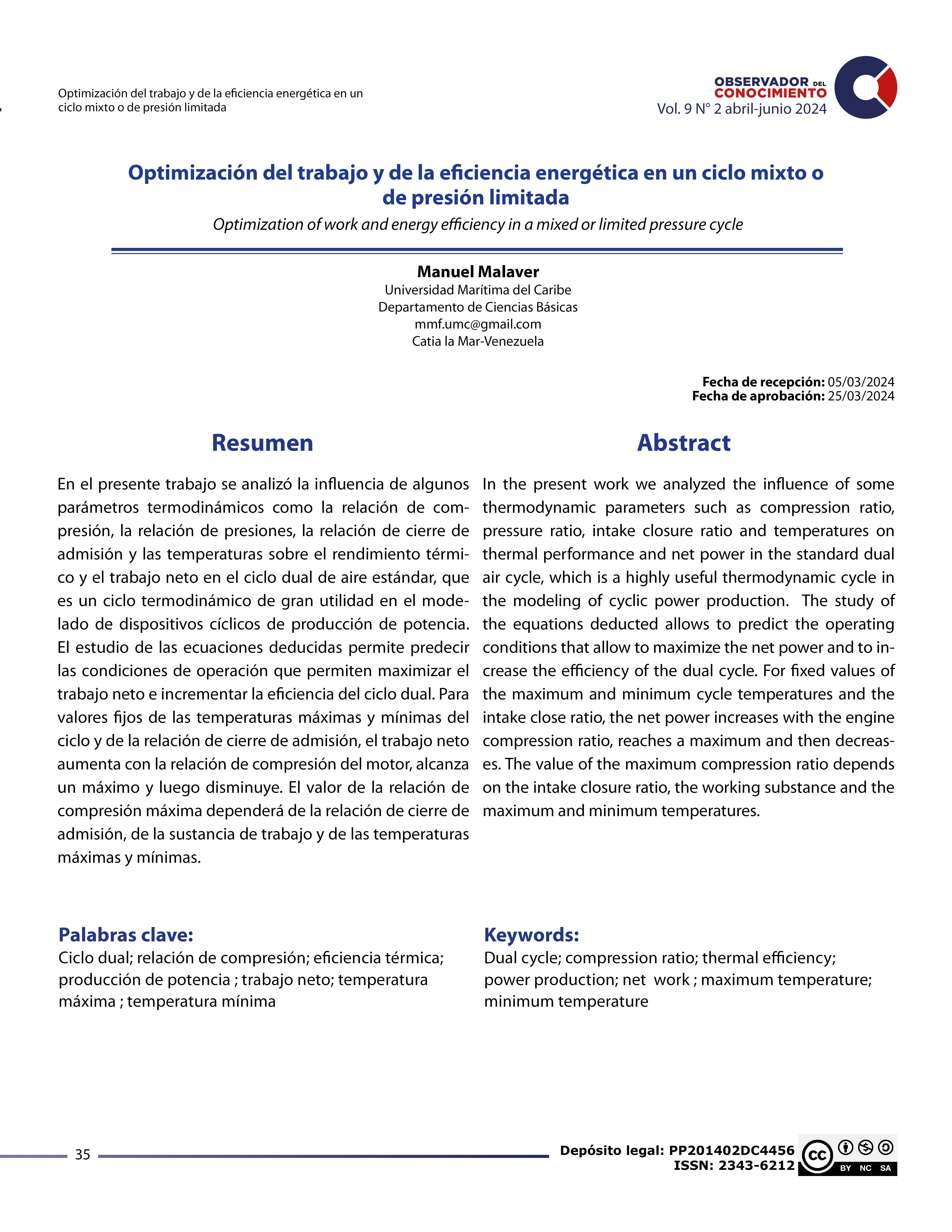Optimization of work and energy efficiency in a mixed or pressure-limited cycle
Keywords:
Dual cycle, compression ratio, thermal efficiency, power production, net work, maximum temperature, minimum temperatureAbstract
In the present work we analyzed the influence of some thermodynamic parameters such as compression ratio, pressure ratio, intake closure ratio and temperatures on thermal performance and net power in the standard dual air cycle, which is a highly useful thermodynamic cycle in the modeling of cyclic power production. The study of the equations deducted allows to predict the operating conditions that allow to maximize the net power and to increase the efficiency of the dual cycle. For fixed values of the maximum and minimum cycle temperatures and the intake close ratio, the net power increases with the engine compression ratio, reaches a maximum and then decreases. The value of the maximum compression ratio depends on the intake closure ratio, the working substance and the maximum and minimum temperatures.
Downloads
References
-Broatch, A. et al. (2019). New Approach to Study the Heat Transfer in Internal Combustion Engines by
D Modeling. Int. J. Therm. Sci. Vol. 138, p.405. https://doi.org/10.1016/j.ijthermalsci.2019.01.006.
-Burghardt, M.D.(1984). Ingeniería Termodinámica. México, D.F: Editorial Harla.
-Cengel, Y. y Boles, M.(2012). Termodinámica. México, D.F: McGraw-Hill Interamericana, S.A.
-Chen, L. et al. (2020). Performance of Universal Reciprocating Heat-Engine Cycle with Variable Specific
Heats Ratio of Working Fluid. Entropy. Vol. 22, p. 397. https:// doi.org/10.3390/e22040397
-Crespi, F. et al. (2020). Potential of Supercritical Carbon Dioxide Power Cycles to Reduce the Levelised
Cost of Electricity of Contemporary Concentrated Solar Power Plants. Applied Sciences. Vol. 10, N° 15,
p.5049. https://doi.org/10.3390/app10155049.
-Curzon, F.L y Ahlborn, B. (1975). Efficiency of a Carnot Engine at maximum power output.
Am.J.Phys.Vol. 43, N°22, p. 22. https://doi. org/10.1119/1.10023.
-Feidt, M. y Costea, M. (2019). Progress in Carnot and Chambadal Modeling of Thermomechanical
Engine by Considering Entropy Production and Heat Transfer.
Entropy. Vol.21, p. 1232. https://doi.org/10.3390/ e21121232.
-Liu, Z. y Karimi, I. (2019). Simulation of a Combined Cycle Gas Turbine Power Plant in Aspen HYSYS. Energy Procedia. Vol.158, p. 3620. https://doi.org/10.1016/j. egypro.2019.01.901.
-Malaver, M. (2012). Optimización del trabajo en un ciclo Brayton con irreversibilidades. Ingeniería,
Vol.22, N°1, p.69. https://doi.org/10.15517/ring.v22i1.8395.
-Méndez, L. et al. (2019). Análisis Termodinámico de las Turbinas de Vapor para los Ciclos Ultracríticos,
Supercríticos, Subcríticos y Geotérmicos. Información ecnológica. Vol. 30, N°4, p. 237. http://dx.doi.
org/10.4067/S0718-07642019000400237.
-Merchán, R.P. et al. (2020). On-Design Pre-Optimization and Off-Design Analysis of Hybrid Brayton
Thermosolar Tower Power Plants for Different Fluids and Plant Configurations. Renewable and
Sustainable Energy Reviews.Vol.119. https://doi.org/10.1016/j.rser.2019.109590.
-Oh, S. et al. (2020). Entropy, Free Energy, and Work of Restricted Boltzmann Machines. Entropy. Vol.
, p. 538. https://doi.org/10.3390/e22050538.
-Ponmurugan, M. (2019). Realistic Thermal Heat Engine Model and its Generalized Efficiency.
arXiv:1912.12949v1. https://arxiv.org/abs/1912.12949.
-Wark, K. J. y Richards, D. (2001). Termodinámica. Madrid: McGraw-Hill Interamericana, S.A.
-Zhu F. et al. (2019). Thermodynamic Analysis and Optimization of an Irreversible Maisotsenko-Diesel
Cycle. J. Therm. Sci. Vol. 28, N°4, p. 659. https://doi. org/10.1007/s11630-019-1153-1.

Downloads
Published
How to Cite
Issue
Section
License
Copyright (c) 2024 Manuel Malaver

This work is licensed under a Creative Commons Attribution-NoDerivatives 4.0 International License.







